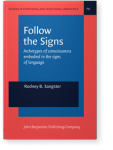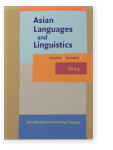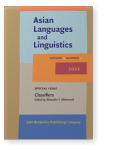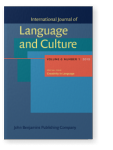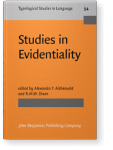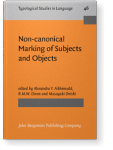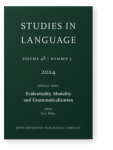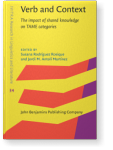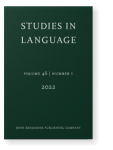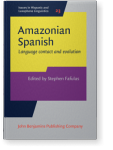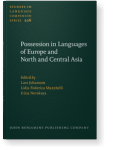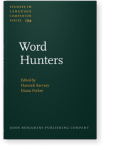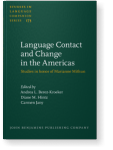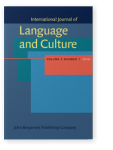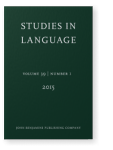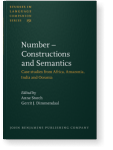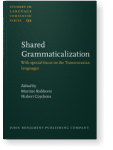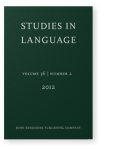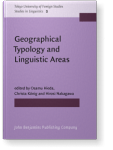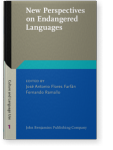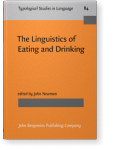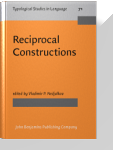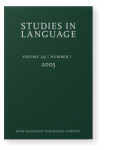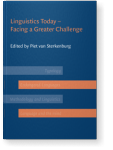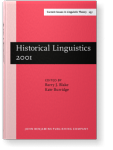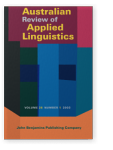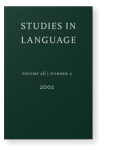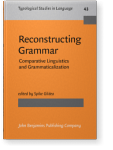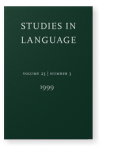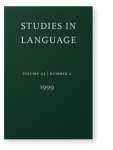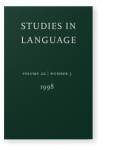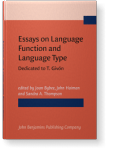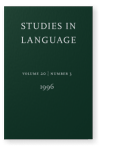Alexandra Y. Aikhenvald
List of John Benjamins publications for which Alexandra Y. Aikhenvald plays a role.
Book series
Journal
ISSN 2665-9336 | E-ISSN 2665-9344
Classifiers
Edited by Alexandra Y. Aikhenvald
Special issue of Asian Languages and Linguistics 3:2 (2022) v, 227 pp.
Subjects Afro-Asiatic languages | Altaic languages | Dravidian languages | Historical linguistics | Japanese linguistics | Sino-Tibetan languages | Theoretical linguistics | Turkic languages | Typology | Uralic languages
Creativity in Language
Edited by Alexandra Y. Aikhenvald, Andrea Hollington, Nico Nassenstein and Anne Storch
Special issue of International Journal of Language and Culture 6:1 (2019) vi, 223 pp.
Subjects Anthropological Linguistics | Applied linguistics | Cognition and language | Cognitive psychology | Communication Studies | Pragmatics
Studies in Evidentiality
Edited by Alexandra Y. Aikhenvald and R.M.W. Dixon
[Typological Studies in Language, 54] 2003. xiv, 349 pp.
Subjects Semantics | Typology
Non-canonical Marking of Subjects and Objects
Edited by Alexandra Y. Aikhenvald, R.M.W. Dixon and Masayuki Onishi
[Typological Studies in Language, 46] 2001. xii, 364 pp.
Subjects Semantics | Syntax | Typology
2024 Speaking about knowledge: Evidentiality and the ecology of language Evidentiality, Modality and Grammaticalization, Mélac, Eric (ed.), pp. 543–574 | Article
We focus on the grammatical expression of four major groups of meanings related to knowledge: I. Evidentiality: grammatical expression of information source; II. Egophoricity: grammatical expression of access to knowledge; III. Mirativity: grammatical expression of expectation of knowledge; and… read more
2023 What everybody knows: Expressing shared knowledge thorough evidentials Verb and Context: The impact of shared knowledge on TAME categories, Rodríguez Rosique, Susana and Jordi M. Antolí Martínez (eds.), pp. 1–18 | Chapter
Every language has a variety of ways of expressing how one knows what one is talking about. In quite a few of the world’s languages, one has to always specify the information source through grammatical means. Evidential terms may combine reference to the information sources of the speaker and of… read more
2022 Beyond nominal tense: Temporality, aspect, and relevance in Tariana noun phrases Studies in Language 46:1, pp. 40–75 | Article
Tariana, an Arawak language from Brazil, has nominal markers which convey temporal and aspectual information about the noun phrase. Besides nominal future, there is a distinction between completed and non-completed nominal pasts. The completed nominal past has three meanings – decessive (‘late,… read more
2022 Classifiers: Setting the scene: An introduction to the special issue on classifiers in the languages of Asia Classifiers, Aikhenvald, Alexandra Y. (ed.), pp. 141–152 | Article
Classifiers are morphemes which occur under specifiable conditions and which categorise nominal referents in terms of their animacy, shape, and other properties. The most widely represented type is numeral classifiers, which occur next to a number word or a quantifier. Further types include noun… read more
2020 Chapter 1. Language loss and language gain in Amazonia: On newly emergent varieties of a national language Amazonian Spanish: Language Contact and Evolution, Fafulas, Stephen (ed.), pp. 7–34 | Chapter
The Amazon Basin is renowned for its high linguistic diversity. The history of Amazonian languages has been marred with language extinction and loss ever since the European conquest. Newly emergent varieties of the national languages – Portuguese and Spanish – bear the substratum influence of the… read more
2019 Expressing ‘possession’: Motivations, meanings, and forms Possession in Languages of Europe and North and Central Asia, Johanson, Lars, Lidia Federica Mazzitelli and Irina Nevskaya (eds.), pp. 7–26 | Chapter
Competing motivations are often at work in the choice of form and meaning of possessive and associative noun phrases. The article offers a broad typological review of the ways of expressing possession at the NP-internal level. In particular, it discusses how iconicity and economic motivations… read more
2019 Hidden from women’s ears: Gender-based taboos in the Vaupés area Creativity in Language, Aikhenvald, Alexandra Y., Andrea Hollington, Nico Nassenstein and Anne Storch (eds.), pp. 95–118 | Article
Across the multilingual area of the Vaupés River Basin in north-west Amazonia, women are considered a dangerous ‘other’. In accordance with the local marriage practices, men marry women from language groups different to their own. Women are denied access to important rituals, such as the Yurupary… read more
2019 Creativity in language: Secret codes, special styles and linguistic taboo Creativity in Language, Aikhenvald, Alexandra Y., Andrea Hollington, Nico Nassenstein and Anne Storch (eds.), pp. 1–9 | Introduction
2018 Chapter 2. The magic of names: A fieldworker’s perspective Word Hunters: Field linguists on fieldwork, Sarvasy, Hannah and Diana Forker (eds.), pp. 9–27 | Chapter
2016 Language contact and word structure: A case study from north-west Amazonia Language Contact and Change in the Americas: Studies in honor of Marianne Mithun, Berez-Kroeker, Andrea L., Diane M. Hintz and Carmen Dagostino (eds.), pp. 297–314 | Article
Intensive language contact between genetically unrelated languages may result in their structural adjustment to each other. The languages will then converge and become similar in their grammar. The effects of language contact are expected to be particularly strong if a dominant language is in the… read more
2016 Gender, shape, and sociality: How humans are special in Manambu International Journal of Language and Culture 3:1, pp. 68–89 | Article
Many languages of the world have genders, that is, grammatical agreement classes, based on such core semantic properties as animacy, sex and humanness, and also shape. In Manambu, a language of New Guinea, nouns are assigned genders according to the sex of a human referent, and to shape and size… read more
2015 Body, mind, and spirit: What makes up a person in Manambu Studies in Language 39:1, pp. 85–117 | Article
In many languages, terms denoting the human body and its parts constitute a closed subclass of nouns with special grammatical properties. Many if not all parts of the human body may acquire dimensions of meanings with ethnographic importance. I focus on a tri-partite division of visible and… read more
2014 Chapter 2. Number and noun categorisation: A view from north-west Amazonia Number – Constructions and Semantics: Case studies from Africa, Amazonia, India and Oceania, Storch, Anne and Gerrit J. Dimmendaal (eds.), pp. 33–56 | Article
A combination of number marking, on the one hand, and genders, animacy and classifiers of various sorts on the other, may form the basis for semantic subcategorisation of nominal referents, in addition to further such devices. The paper investigates number as a noun categorisation device in a… read more
2013 Chapter 2. Areal diffusion and parallelism in drift: Shared grammaticalization patterns Shared Grammaticalization: With special focus on the Transeurasian languages, Robbeets, Martine and Hubert Cuyckens (eds.), pp. 23–42 | Chapter
Shared features, and especially shared grammaticalization patterns, may result from geographic proximity, contact, and borrowing (“copying”). Related languages “will pass through the same or strikingly similar phases”: this “parallelism in drift” (Sapir 1921: 171‒172) accounts for additional… read more
2011 Areal Features and Linguistic Areas: Contact-induced Change and Geographical Typology Geographical Typology and Linguistic Areas: With special reference to Africa, Hieda, Osamu, Christa König and Hiroshi Nakagawa (eds.), pp. 13–39 | Article
2010 The social life of a language: Will Manambu survive? New Perspectives on Endangered Languages: Bridging gaps between sociolinguistics, documentation and language revitalization, Flores Farfán, José Antonio and Fernando F. Ramallo (eds.), pp. 13–28 | Article
The island of New Guinea is probably the most linguistically diverse and complex area in the world. The Sepik river basin displays cultural as well as linguistic diversity and fragmentation, perhaps more so than other areas of New Guinea. Many of the Sepik languages show signs of endangerment.… read more
2009 'Eating', 'drinking' and 'smoking': A generic verb and its semantics in Manambu The Linguistics of Eating and Drinking, Newman, John (ed.), pp. 91–108 | Article
Many of the world’s languages have different forms for the concepts of ‘eating’ (solid food) and ‘drinking’ (liquid). Manambu, from the Ndu family in the Sepik region of New Guinea, has the same verb covering the notions of ‘eating’, ‘drinking’, smoking’ and ‘breast-feeding’. It also refers to… read more
2007 30. Reciprocal and sociative, reflexive and reciprocal in Tariana: Their genetic and areal properties Reciprocal Constructions, Nedjalkov, Vladimir P. (ed.), pp. 1351–1366 | Chapter
2007 20. Reciprocals and reflexives in North Arawak languages of the Upper Rio Negro (Warekena, Bare, Baniwa of Içana) Reciprocal Constructions, Nedjalkov, Vladimir P. (ed.), pp. 845–855 | Chapter
2005 Review of König (2002): Kasus im Ik Studies in Language 29:1, pp. 200–207 | Review
2004 Evidentiality: Problems and challenges Linguistics Today – Facing a Greater Challenge, Sterkenburg, Piet van (ed.), pp. 1–30 | Article
2003 1. Evidentiality in typological perspective Studies in Evidentiality, Aikhenvald, Alexandra Y. and R.M.W. Dixon (eds.), pp. 1–31 | Chapter
2003
Language contact and language change in Amazonia
Historical Linguistics 2001: Selected papers from the 15th International Conference on Historical Linguistics, Melbourne, 13–17 August 2001, Blake, Barry J. and Kate Burridge (eds.), pp. 1–20 | Article2003 6. Evidentiality in Tariana Studies in Evidentiality, Aikhenvald, Alexandra Y. and R.M.W. Dixon (eds.), pp. 131–164 | Article
2002 Review of Seiler (2000): Language Universals Research: a Synthesis Studies in Language 26:2, pp. 502–504 | Review
2001 Review of Gildea (1998): On reconstructing grammar: Comparative Cariban morphosyntax Diachronica 18:1, pp. 139–144 | Review
2001 Verb types, non-canonically marked arguments and grammatical relations: A Tariana perspective Non-canonical Marking of Subjects and Objects, Aikhenvald, Alexandra Y., R.M.W. Dixon and Masayuki Onishi (eds.), pp. 177–200 | Article
2000 Areal typology and grammaticalization: The emergence of new verbal morphology in an obsolescent language Reconstructing Grammar: Comparative Linguistics and Grammaticalization, Gildea, Spike (ed.), pp. 1–38 | Article
1999 Serial Constructions and Verb Compounding Evidence from Tariana (North Arawak) Studies in Language 23:3, pp. 469–497 | Article
Tariana, a North Arawak language from northwest Amazonia, has a complex system of serial verbs and a certain amount of verb compounding. Serial verbs in Tariana provide important evidence in favour of the existence of cross-linguistically valid defining properties of serial verbs. Verb… read more
1999 Review of Plank (1995): Double case: Agreement by Suffixaufnahme Studies in Language 23:2, pp. 447–454 | Review
1998 Review of Harvey & Reid (1997): Nominal Classification in Aboriginal Australia Studies in Language 22:3, pp. 693–703 | Review
1997 A Typology of Argument-Determined Constructions Essays on Language Function and Language Type: Dedicated to T. Givón, Bybee, Joan L., John Haiman and Sandra A. Thompson (eds.), pp. 71–114 | Article
1996 Words, Phrases, Pauses and Boundaries: Evidence from South American Indian Languages Studies in Language 20:3, pp. 487–517 | Article
This paper discusses the phonological properties of words and phrases in two Northern Arawak languages of the Upper Rio Negro, Brazil. These features are h-prosody, vowel harmony triggered by the glottal fricative h, vowel nasalization and vowel diphthongization. A feature that is used to mark a… read more
